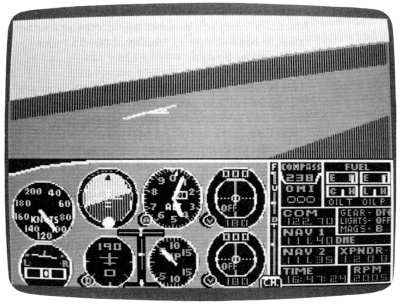40 Great Flight Simulator Adventures
by Charles Gulick

A Sound
Approach
Approach
| North Position: 17606 | Rudder: 32767 |
| East Position: 22132 | Ailerons: 32767 |
| Altitude: 4468 | Flaps: 0 |
| Pitch: 0 | Elevators: 33023 (IBM only) |
| Bank: 0 | Elevators: 37119 (all except IBM) |
| Heading: 238 | Time: 16:44 |
| Airspeed: 126 | Season: 3-Summer |
| Throttle: 22000 (IBM only) | Wind: 15 Kts, 180 |
| Throttle: 19952 (all except IBM) |
| Approximately 20 nautical miles
ahead of you is Martha's Vineyard, a
resort island off the southern coast of Massachusetts. You're about 55
miles southeast of Boston. |
|
 |
Access radar and adjust your
zoom until you see the mainland and two
somewhat triangular islands. The section of mainland you're over is
Cape Cod, itself an island by virtue of a canal which divides it from
the spherical land mass on your right. The body of water there and
behind you is Cape Cod Bay. The triangular island to the left is Nantucket, where, sad to say, elegant museums and artifacts commemorate sea captains who amassed great wealth hunting and killing whales. The water you're over now is Nantucket Sound. Go to the out-the-windshield view. |
 |
Tune NAV 2 to Martha's Vineyard
VOR, 108.2, and you'll find you're on
or close to the 240degree radial. Tune NAV 1 to the Martha's Vineyard
ILS (Instrument Landing System) frequency, 108.7, and set the OBI to
240 with a TO indication. Fly that needle to get on the 240 radial. When your DME reads 17 to 18 nautical miles, you'll see the Martha's Vineyard airport straight ahead. You're on a long final for runway 24. The objectives here, besides sightseeing, are to practice setting up a pattern approach speed and tracking the glideslope needle. This long approach gives you a chance to experiment and familiarize yourself with glidepath vagaries. The horizontal needle represents the desired glideslope. Don't sweat it, however, until it moves toward the center of the instrument. Then it's ready to work. Reduce power and set up your approach. Use flaps or not to suit yourself. Adjust pitch to get and keep the glideslope needle centered. And use power to maintain the desired airspeed. Or use them in any combination that you've learned or that suits you. Meanwhile, keep the vertical needle centered. That sounds so simple, doesn't it? But if you're new to this sort of thing, you'll find your eyes are glued to the instruments (note plural). You'll think there must be an awful lot of turbulence or something up here. When the glideslope needle goes below the centerline-as it surely will-give down elevator and/or reduce power. When the needle goes above the line-as it just as surely will, oftengive up elevator and/or.... But keep everlastingly at it. Get on top of it. Anticipate. Coax. Fight. Encourage. Fly the thing. Don't let it fly you. Just as everlastingly, try to maintain your approach speed. Your eyes will dance (through the glue) from the airspeed indicator to the glideslope needle, and back and forth, and you may get into some wild attitude and airspeed configurations, depending on your experience. It's a charming and challenging game. And don't forget to keep lined up with the runway. (At least you have visual contact on this flight, for which be thankful, but if you're inspired, use just the ILS vertical needle, which indicates the runway centerline.) Listen for the outer marker signal. And slow to landing speed for the flare. This is a neat way to spend a Sunday afternoon, particularly if it's raining outside (real world). But at some time or another, it says here, persistence is supposed to win. Probably when you least expect it, you'll find you've very prettily set her down-and right on the money. So when you feel you have the hang of it, add some clouds with bottoms around 250 feet (field elevation is 68 feet) and fly the ILS for real. |
Table of Contents | Previous Section | Next Section
